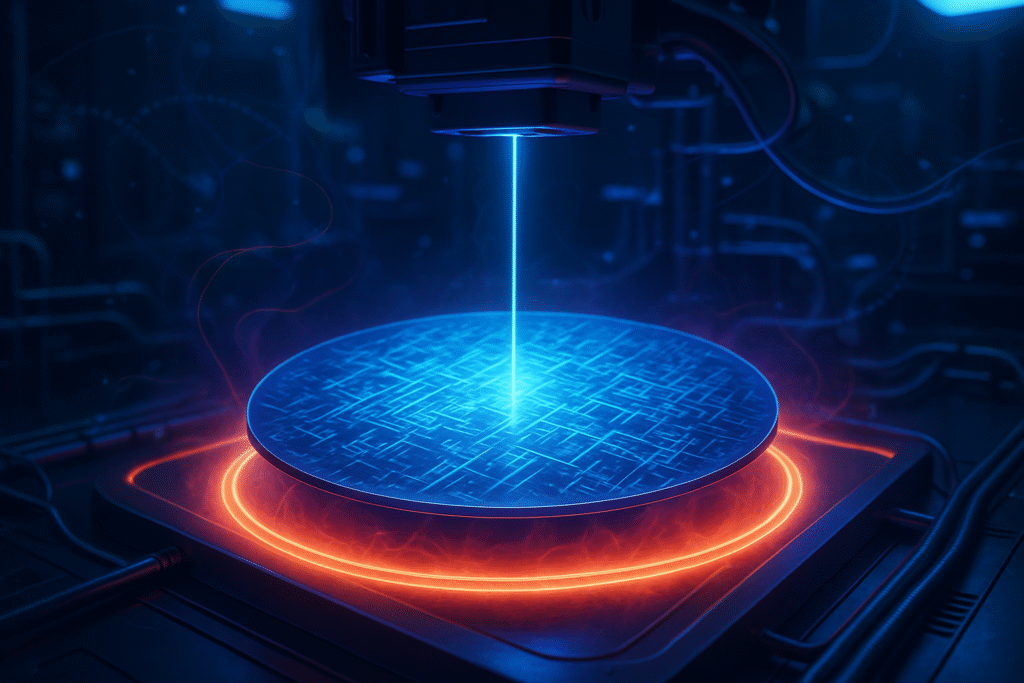
As the world hurls towards an increasingly AI-driven future, the foundational technologies that enable advanced artificial intelligence are undergoing silent but profound transformations. Among these, the Molybdenum Disilicide (MoSi2) heating element market is rapidly ascending, poised for substantial growth between 2025 and 2032. These high-performance elements, often unseen, are absolutely critical to the intricate processes of semiconductor manufacturing, particularly in the creation of the sophisticated chips that power AI. With market projections indicating a robust Compound Annual Growth Rate (CAGR) of 5.6% to 7.1% over the next seven years, this specialized segment is set to become an indispensable pillar supporting the relentless innovation in AI hardware.
The immediate significance of MoSi2 heating elements lies in their unparalleled ability to deliver and maintain the extreme temperatures and precise thermal control required for advanced wafer processing, crystal growth, epitaxy, and heat treatment in semiconductor fabrication. As AI models grow more complex and demand ever-faster, more efficient processing, the underlying silicon must be manufactured with unprecedented precision and purity. MoSi2 elements are not merely components; they are enablers, directly contributing to the yield, quality, and performance of the next generation of AI-centric semiconductors, ensuring the stability and reliability essential for cutting-edge AI applications.
The Crucible of Innovation: Technical Prowess of MoSi2 Heating Elements
MoSi2 heating elements are intermetallic compounds known for their exceptional high-temperature performance, operating reliably in air at temperatures up to 1800°C or even 1900°C. This extreme thermal capability is a game-changer for semiconductor foundries, which require increasingly higher temperatures for processes like rapid thermal annealing (RTA) and chemical vapor deposition (CVD) to create smaller, more complex transistor architectures. The elements achieve this resilience through a unique self-healing mechanism: at elevated temperatures, MoSi2 forms a protective, glassy layer of silicon dioxide (SiO2) on its surface, which prevents further oxidation and significantly extends its operational lifespan.
Technically, MoSi2 elements stand apart from traditional metallic heating elements (like Kanthal alloys) or silicon carbide (SiC) elements due to their superior oxidation resistance at very high temperatures and their excellent thermal shock resistance. While SiC elements offer high temperature capabilities, MoSi2 elements often provide better stability and a longer service life in oxygen-rich environments at the highest temperature ranges, reducing downtime and maintenance costs in critical manufacturing lines. Their ability to withstand rapid heating and cooling cycles without degradation is particularly beneficial for batch processes in semiconductor manufacturing where thermal cycling is common. This precise control and durability ensure consistent wafer quality, crucial for the complex multi-layer structures of AI processors.
Initial reactions from the semiconductor research community and industry experts underscore the growing reliance on these advanced heating solutions. As feature sizes shrink to nanometer scales and new materials are introduced into chip designs, the thermal budgets and processing windows become incredibly tight. MoSi2 elements provide the necessary precision and stability, allowing engineers to push the boundaries of materials science and process development. Without such robust and reliable high-temperature sources, achieving the required material properties and defect control for high-performance AI chips would be significantly more challenging, if not impossible.
Shifting Sands: Competitive Landscape and Strategic Advantages
The escalating demand for MoSi2 heating elements directly impacts a range of companies, from material science innovators to global semiconductor equipment manufacturers and, ultimately, the major chipmakers. Companies like Kanthal (a subsidiary of Sandvik Group (STO: SAND)), I Squared R Element Co., Inc., Henan Songshan Lake Materials Technology Co., Ltd., and JX Advanced Metals are at the forefront, benefiting from increased orders and driving innovation in element design and manufacturing. These suppliers are crucial for equipping the fabrication plants of tech giants such as Taiwan Semiconductor Manufacturing Company (TSMC (NYSE: TSM)), Intel Corporation (NASDAQ: INTC), and Samsung Electronics Co., Ltd. (KRX: 005930), which are continuously investing in advanced manufacturing capabilities for their AI chip production.
The competitive implications are significant. Companies that can provide MoSi2 elements with enhanced efficiency, longer lifespan, and greater customization stand to gain substantial market share. This fosters a competitive environment focused on R&D, leading to elements with improved thermal shock resistance, higher purity, and more complex geometries tailored for specific furnace designs. For semiconductor equipment manufacturers, integrating state-of-the-art MoSi2 heating systems into their annealing, CVD, and epitaxy furnaces becomes a key differentiator, offering their clients superior process control and higher yields.
This development also reinforces the strategic advantage of regions with robust semiconductor ecosystems, particularly in Asia-Pacific, which is projected to be the fastest-growing market for MoSi2 elements. The ability to produce high-performance AI chips relies heavily on access to advanced manufacturing technologies, and reliable access to these critical heating elements is a non-negotiable factor. Any disruption in the supply chain or a lack of innovation in this sector could directly impede the progress of AI hardware development, highlighting the interconnectedness of seemingly disparate technological fields.
The Broader AI Landscape: Enabling the Future of Intelligence
The proliferation and advancement of MoSi2 heating elements fit squarely into the broader AI landscape as a foundational enabler of next-generation computing hardware. While AI itself is a software-driven revolution, its capabilities are intrinsically tied to the performance and efficiency of the underlying silicon. Faster, more power-efficient, and densely packed AI accelerators—from GPUs to specialized NPUs—all depend on sophisticated manufacturing processes that MoSi2 elements facilitate. This technological cornerstone underpins the development of more complex neural networks, faster inference times, and more efficient training of large language models.
The impacts are far-reaching. By enabling the production of more advanced semiconductors, MoSi2 elements contribute to breakthroughs in various AI applications, including autonomous vehicles, advanced robotics, medical diagnostics, and scientific computing. They allow for the creation of chips with higher transistor densities and improved signal integrity, which are crucial for processing the massive datasets that fuel AI. Without the precise thermal control offered by MoSi2, achieving the necessary material properties for these advanced chip designs would be significantly more challenging, potentially slowing the pace of AI innovation.
Potential concerns primarily revolve around the supply chain stability and the continuous innovation required to meet ever-increasing demands. As the semiconductor industry scales, ensuring a consistent supply of high-purity MoSi2 materials and manufacturing capacity for these elements will be vital. Comparisons to previous AI milestones, such as the initial breakthroughs in deep learning, highlight that while the spotlight often falls on algorithms and software, the hardware advancements that make them possible are equally transformative. MoSi2 heating elements represent one such silent, yet monumental, hardware enabler, akin to the development of better lithography tools or purer silicon wafers in earlier eras.
The Road Ahead: Innovations and Challenges on the Horizon
Looking ahead from 2025, the MoSi2 heating element market is expected to witness continuous innovation, driven by the relentless demands of the semiconductor industry and other high-temperature applications. Near-term developments will likely focus on enhancing element longevity, improving energy efficiency further, and developing more sophisticated control systems for even finer temperature precision. Long-term, we can anticipate advancements in material composites that combine MoSi2 with other high-performance ceramics or intermetallics to create elements with even greater thermal stability, mechanical strength, and resistance to harsh processing environments.
Potential applications and use cases are expanding beyond traditional furnace heating. Researchers are exploring the integration of MoSi2 elements into more localized heating solutions for advanced material processing, additive manufacturing, and even novel energy generation systems. The ability to create customized shapes and sizes will facilitate their adoption in highly specialized equipment, pushing the boundaries of what's possible in high-temperature industrial processes.
However, challenges remain. The cost of MoSi2 elements, while justified by their performance, can be higher than traditional alternatives, necessitating continued efforts in cost-effective manufacturing. Scaling production to meet the burgeoning global demand, especially from the Asia-Pacific region's expanding industrial base, will require significant investment. Furthermore, ongoing research into alternative materials that can offer similar or superior performance at comparable costs will be a continuous challenge. Experts predict that as AI's demands for processing power grow, the innovation in foundational technologies like MoSi2 heating elements will become even more critical, driving a cycle of mutual advancement between hardware and software.
A Foundation for the Future of AI
In summary, the MoSi2 heating element market, with its projected growth from 2025 to 2032, represents a cornerstone technology for the future of artificial intelligence. Its ability to provide ultra-high temperatures and precise thermal control is indispensable for manufacturing the advanced semiconductors that power AI's most sophisticated applications. From enabling finer transistor geometries to ensuring the purity and integrity of critical chip components, MoSi2 elements are quietly but powerfully driving the efficiency and production capabilities of the AI hardware ecosystem.
This development underscores the intricate web of technologies that underpin major AI breakthroughs. While algorithms and data capture headlines, the materials science and engineering behind the hardware provide the very foundation upon which these innovations are built. The long-term impact of robust, efficient, and reliable heating elements cannot be overstated, as they directly influence the speed, power consumption, and capabilities of every AI system. As we move into the latter half of the 2020s, watching the advancements in MoSi2 technology and its integration into next-generation manufacturing processes will be crucial for anyone tracking the true trajectory of artificial intelligence.
This content is intended for informational purposes only and represents analysis of current AI developments.
TokenRing AI delivers enterprise-grade solutions for multi-agent AI workflow orchestration, AI-powered development tools, and seamless remote collaboration platforms.
For more information, visit https://www.tokenring.ai/.





